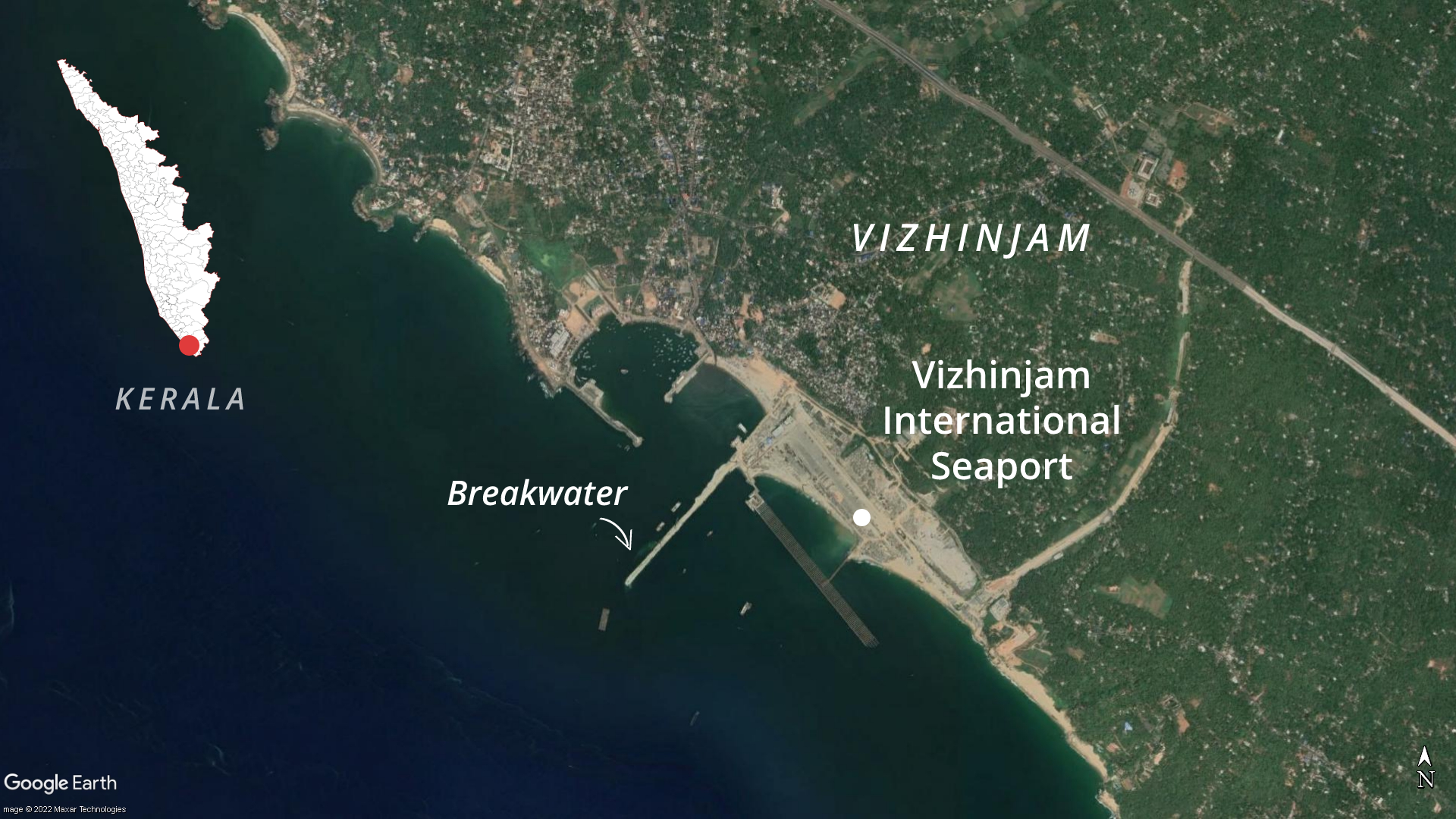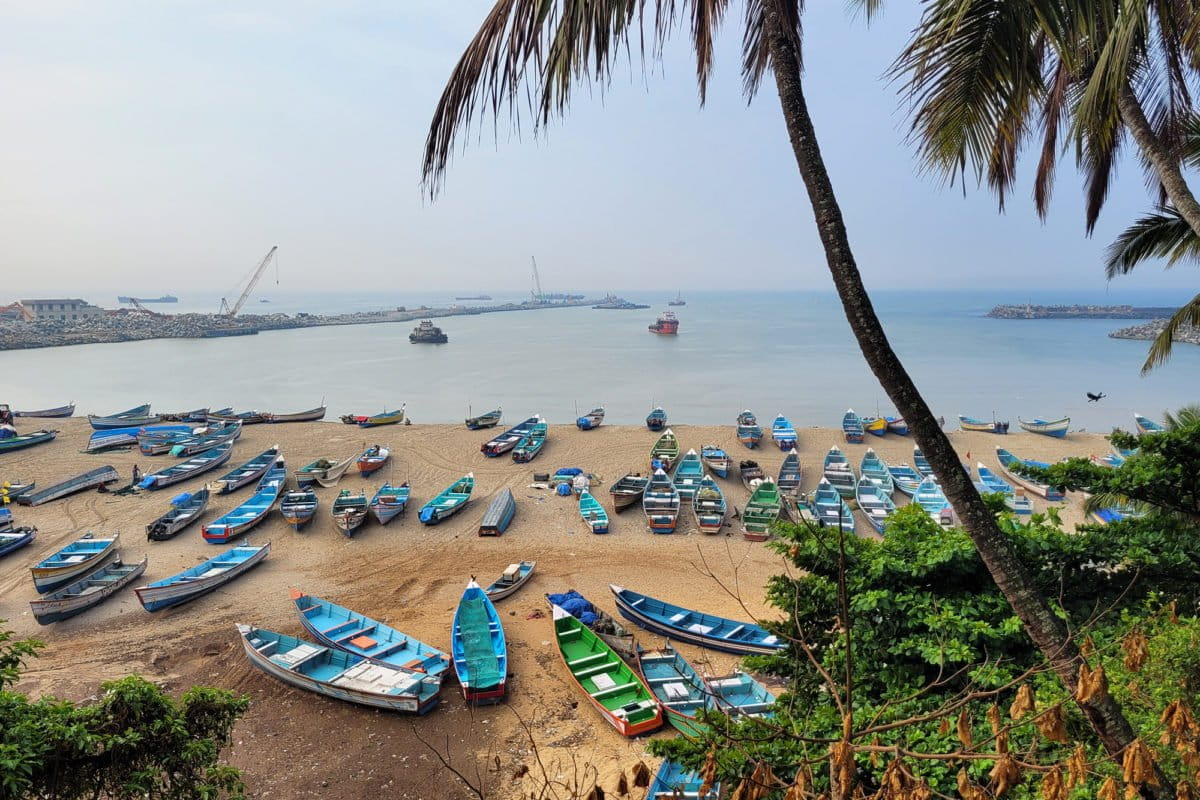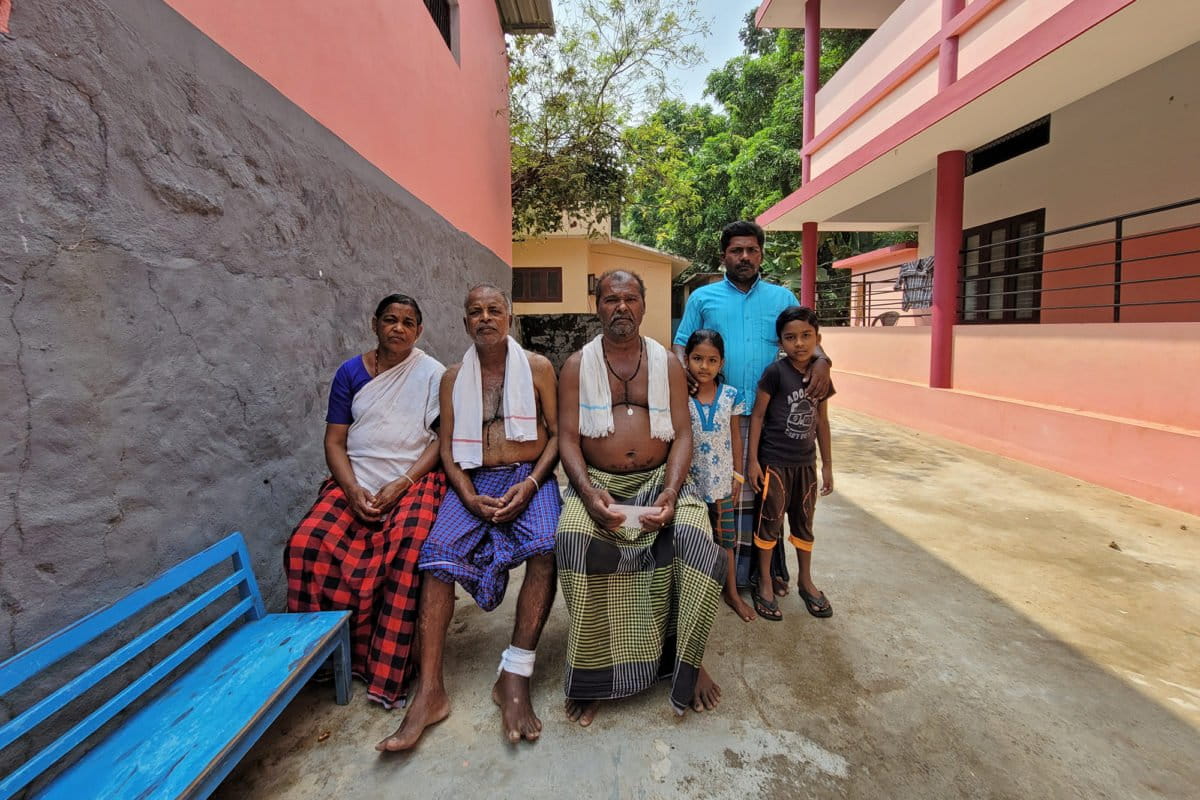- Vizhinjam International Seaport is an ‘international transhipment deepwater multipurpose seaport’ that is being developed by Adani Ports in a public-private partnership model with the government of Kerala. After going through a series of objections and court cases filed by environmentalists and citizen activists, the port secured all clearances for construction in 2015.
- However, over the last seven years, Vizhinjam and its neighbouring villages have witnessed a steep fall in marine biodiversity, a decline in fish catch, loss of thousands of livelihoods, uncomfortable rehabilitations, and a general sense of misery amongst its populace.
- Experts warn that port activity will destroy the wadge bank, a unique fertile fishing ground in the ocean, and rich in biodiversity, like a warehouse for feeding fish. There are 20 wadge banks around the world and one of them is situated southwest of the coastline of Kanyakumari in south India.
- While the port is soon going to become a reality, and compensations are being provided for livelihood and land lost, the affected people argue it is not enough.
“Vizhinjam was once known as the harbour of pro-creation,” Father Michael, parish priest of Lady of Good Voyage Church in Vizhinjam, Kerala, told Mongabay-India. But today, the reality is different.
Vizhinjam is a coastal region approximately 16 kilometres south of Trivandrum, stretched between Kollam and Kanyakumari in the southern district of Kerala. The seabed in this area is full of rock formations, sandy bottom ridges, floor slopes and sloping ridges, making the space a rich breeding ground for mussels and a variety of marine organisms.
At least 12 unique reef systems have been discovered here, say researchers from Friends of Marine Life, an indigenous coastal community non-profit composed of scientists, scuba divers and fishers in south India. In 2016, they carried out a survey of the sea bed of Vizhinjam, to document the biodiversity of the region. Kumar Sahayaraju, a marine biotechnologist, who was part of the team, told Mongabay-India that the region is “like a forest in the sea.”
“The sea bed is full of sessile and sedentary marine life. There are at least 12 different reefs, forming the perfect habitat for fish to live and breed. And now they don’t have a home,” he said.
Father Michael said, “fishers from all the 20 coastal villages surrounding us would come here during the monsoon months to fish.”
This ecologically rich region is also the site of the Vizhinjam International Sea Port, an ‘international transhipment deepwater multipurpose seaport’ that is being developed by Adani Ports as a public-private partnership (PPP) project on a design, build, finance, operate and transfer (DBFOT) basis. The PPP structure is based on a landlord model where land will be owned by the Government of Kerala (GoK) through Vizhinjam International Seaport Limited (VISL), a special purpose vehicle set up to manage the port development.

The project has been in the making for a long time. The port’s development was envisaged by the Kerala government in 1999 and the site was chosen primarily because of the geomorphological features of this region — Vizhinjam has a natural bay, a natural depth of 18-20 metres that would allow the parking of cape-size vessels without additional dredging. And it is only about ten nautical miles from the international shipping route of Malacca strait, one of the busiest shipping channels. Capesize vessels are large-sized bulk carriers typically above 150,000 deadweight tonnage (DWT). Due to their large dimensions and deep draughts, they are suitable to serve only large ports with deep water terminals in the world.

The site seemed like the perfect pit stop for cargo vessels passing by. It is designed to cater to container transhipment besides multi-purpose and breakbulk cargo. The private partner, Adani Vizhinjam Port Private, manages the port including the civil infrastructure, supra-structure (terminal) and provides cargo handling services to the port users.
The construction of the project started in 2015 and it involved reclaiming 130 acres of land from the sea, building a new harbour, a jetty with pillars to allow the parking of capesize vessels, breakwaters running up to three kilometres, and dredging of shipping channels. According to the master plan, the total requirement of the land for the project is about 238 hectares. Of the total land required for the project, about 30 percent of the land is to be used for real estate development in the form of hotels, commercial buildings and residential apartments.
Not that there wasn’t any protest against it but after going through a series of objections and court cases filed by environmentalists and citizen activists, the port received all clearances and commenced construction on December 5, 2015. It is now slated to be commissioned by October 2023.
For the people of Vizhinjam, life has been divided into two parts – before the port, and after the port. They say it wasn’t as if everything was rosy before the port was constructed. They were sold the idea of a dream destination, that the port will bring them new opportunities, a better, more secure future. But the reality could not be further from this dream.
According to the local people and experts, who are working in the area, Vizhinjam and its neighbouring villages have, over the last seven years, witnessed a steep fall in marine biodiversity, a decline in fish catch, loss of thousands of livelihoods, a rise in the number of fisher deaths, coastal erosion, uncomfortable rehabilitations, and a general sense of misery amongst its populace. For the people, from a harbour of pro-creation, it has become a harbour of desolation.

Has dredging and drilling for Vizhinjam destroyed reefs?
Fishers and local marine experts say that the reefs are getting destroyed because of the continuous dredging work to build a shipping channel.
Dredging is the process of removing accumulated sediment from the banks or bottom of bodies of water. A dredge is a specialised piece of equipment that creates a vacuum to suck up and pump out the unwanted sediment and debris. Like trawling, it is a noisy activity and increases the turbidity of water. Pollution from the noise and turbidity rise decreases water quality, and the dredging itself destroys the reefs, thus destroying an entire ecosystem where fish thrive and breed. “Now, the seabed is like a cemetery of water with no life. How and why will fish be here? They will disappear into the sea in search of a better habitat,” said Kumar Sahayaraju.
A wadge bank is an area that is a fertile fishing ground in the ocean and rich in biodiversity. Since the impacts of strong currents, waves and tides are rather low this area can build up a wealth of nutrients and fish food. It is also a favourable spawning and breeding ground for fish and other marine animals. Throughout the world, there are 20 wadge banks, out of which, one is situated in the southwest direction from the coastline of the Kanyakumari district, India.
“It is like a warehouse, a feeding house for the fishes,” explained Sahayaraju. A number of reef systems exist in this region with over 200 varieties of rare fish species and more than 60 kinds of aquatic species. “This whole harbour is like a bus stand for the fish. Many fish stay here, and many move from one place to another, but always stopover to feed or breed. We are destroying this warehouse, where the marine life and livelihood of the southwest coast depends,” he said.
An underwater video of Vizhinjam shot in February 2015. Video from Robert Panipillai’s group of divers/Josph Vijayan.
The Environment Impact Assessment (EIA) report for the Vizhinjam project created by L&T Ramboll Consulting Engineers Ltd in May 2013, in fact, acknowledges the presence of the wadge bank, adding that the international shipping route with several thousands of ship movements per year, located at about 18 km from Vizhinjam is routed through this wadge bank. But it dismisses concerns about the destruction of its biodiversity as “endangered species like leatherback turtles, Olive Ridley turtles, Risso dolphins, Devil rays, Green turtles and Hawksbill turtles are rarely present around the project area.”
Biju Kumar, head of the aquatic biology unit at Kerala University, said “when you sanction a project, they always take into account rare and endangered species only.”
“We cannot scientifically prove that the biodiversity found in this region is rare or endangered. If we can’t prove that the species are under threat, then the project will go on,” he told Mongabay-India. According to him, the project proponents are only concerned about rare and endangered species because, in their view, only those need to be safeguarded.
The draft National Fisheries Policy 2020 proposed by the government of India talks about making efforts toward “mainstreaming biodiversity conservation” for better fisheries management, conservation of threatened species and artificial reef restoration measures; but it does not talk about taking protective measures for existing marine biodiversity for coastal infrastructure projects. Similarly, Sagarmala, an initiative to promote port-led development of the country has no emphasis on biodiversity protection measures during port constructions.

Read more: Draft National Fisheries Policy seeks big growth but ignores fishers
“It’s like a fish famine here”
When Jacob Bamion, 45, takes his small motorboat out to sea, he spends a minimum of Rs. 3,000 per trip. He earns anything upto Rs. 5,000 on a trip or sometimes nothing at all. Since cyclone Ockhi in December 2017, the sea has become extremely unpredictable, he said. “We used to get an abundance of fish — nottoli (anchovy), ayala (mackerel), chhala (sardine), chilaw (barracuda) and vala (ribbon fish). But now the availability has reduced drastically,” Bamion told Mongabay-India.
Numerous studies and reports have shown that the past decade has witnessed a steady decline in fish catch across India’s coastline. In 2020, Kerala witnessed a 15 percent decline in fish catch. The reasons are aplenty and include the effects of climate change, trawling, pollution and coastal development. But site-specific studies that draw out reasons for the decline in fish catch of indicator species are still rare in the country.
In September 2021, the International Journal of Fisheries and Aquatic Studies published a study by Kumar Sahayaraju and Johnson Jament titled “Loss of marine fish stock in south west India: Examining the causes from the perspective of indigenous fishermen.” The study documents the region around Vizhinjam. They conducted deep focus groups with indigenous fishers through the “Kadalkoodam”, an Ocean Literacy Program conducted by the Coastal Students Cultural Forum, a community of coastal students in the district. Friends of Marine Life conducted a study of the sea bed to validate the interviews.
The study shows that each traditional fishing village in Trivandrum has at least one natural reef on its coast. These reefs and the fish they inhabit play a significant role in the regional economy of the village. For instance, Karumkulam, a fishing village in the study area gets most of its finance from the catch of file-fishes of the Balistidae family, locally known as klathi. Klathi (Odonusniger) resides in the reefs of Karumkulam coast. So if the reef system declines, the entire local economy of that particular village also collapses.

“We have a habit of blaming everything on sea-level rise and global warming,” said Kumar Sahayaraju. “I am not denying it. It is happening. There is a gradual increase of sea surface temperature as the fishermen said – from their indigenous knowledge they said that five to ten years ago they used to feel cold inside the sea but now feel warm.”
But the fish had an ecosystem to thrive, he explained, adding that seabed ecosystems capture the warming gases and balance the effect of climatic changes. Now they don’t even have that, he said while stating that they feel compelled to move deeper and deeper into the ocean. Some who don’t have the resilience to cope with climatic change and ecosystem loss are at threat of extinction.
“My argument is that natural resources have the ability to cope with climate change impacts, but we have destroyed them. So this kind of development, destroying the natural resilience of the sea furthers the climate change impact as well,” he concluded.
Fishing boats returning to Vizhinjam’s shore in the evening. Video by Supriya Vohra/Mongabay.
Read more: Potential offshore wind project in the Gulf of Mannar leaves fishers anxious
No fish found, no fishing allowed, no livelihood
Sudhi Dausan is a 45-year-old former fisher living in Kottapuram ward of Vizhinjam. For the past year, he has been sitting at home. His body is covered with red rashes, which he says are allergies because of the muddy water supply. His liver is weak. His wife works as a house-help, earning Rs. 6,000 a month. They have two children. One is studying to be a nurse, and the other is studying to be a fireman.
Dausan does not own a boat or fishing nets but used to work with boat owners and net owners. When the port construction began, hundreds of fishers like him were told that they would no longer be allowed to fish near the shore as dedicated no-fishing zones and shipping channels were coming up. They were assured of compensation of Rs. 560,000. He received his first instalment of compensation of Rs. 250,000 through a cheque in April 2016. He waited for the second instalment but it never arrived in 2016. In May 2017, the entire village went on a strike protesting the construction of the port. His second compensation of Rs. 310,000 came in November 2017.
The entire amount of Rs. 560,000, if broken down, comes out to be approximately Rs. 300 per day for five years – which is the average daily labour wage for five years. This is the lifelong compensation Dausan received. He can no longer go fishing. He now lives in a flood-prone house and has spent the entire amount on house repairs.
When mechanised fishing was trying to make its way into the country in the 1960s, and industrial methods of fishing were creeping in, the traditional fishers of Trivandrum showed the most resistance. The people stuck to their artisanal methods of fishing. Even today, locals emphasise, a majority of the fishers engage in traditional methods of fishing – using wooden boats called kattumaram, velum stitched boats, the large near-shore nets called kambaval that can employ up to 50 people at a time. These methods are near-shore fishing methods and “10,000 direct livelihoods depend on it,” Paniyadima, the town councillor of Kottapuram, told Mongabay-India.

Prasheet Kumar is a 50-year-old (chippi/kakka) clam collector from Kovalam, a coastal village next to Vizhinjam. He has been catching clams in his kattumaram for over 35 years. He takes his boat a few metres into the sea, stops by a rocky region, and dives underwater where he stays for a maximum of one minute at a time. He uses a knife-like instrument to extract the clam shells from the rocks. He used to earn Rs. 1,000-1,500 a day. Now, the dredging has filled all rocks with sand, which enters the clams, killing them. Now, he doesn’t even earn Rs. 200 a day. He is looking for other jobs.
Parish Councillor Leo Stanley commented that the situation for women, whose primary livelihood as fish vendors is no longer practical, is getting worse. “All you have to do is stand at the Vizhinjam bus stop at about 5-6 a.m., and you will see hundreds of women crowded, all wanting to head to the city. They have to look for work in the city because we have run out of fish to sell,” Stanley told Mongabay-India.
Vizhinjam International Seaport Ltd (VISL), a government outfit responsible for implementing the project and rehabilitation measures, has given a breakdown of the numbers of people that have been affected by the project. According to it, a total of 2,640 people, which includes 262 mussel/clam collectors, 913 shoreseine owners and workers while 1,221 kerosene beneficiaries (small scale fishers) have been compensated for the loss of livelihood.

Seine fishing is a method of fishing that uses a large surrounding net, called a seine, that hangs vertically in the water with its bottom edge held down by weights and its top edge buoyed by floats. Seine nets can be deployed from the shore, or from a boat. Seine nets deployed from the shore are called shoreseines.
At the time of publishing this piece, Vizhinjam International Seaport Ltd (VISL) had not responded to queries sent to them by Mongabay-India on the issue.
“Today our fishers have no space to keep their nets and boats, are not allowed to fish near the shores, have to spend more to go far to find fish, and have received a paltry sum that is meant to last them a lifetime? They want us to stop existing,” said Paniyadima.

Read more: India needs more conservation-relevant research on sharks and rays
Banner image: Fish catch in Vizhinjam. After the port construction began, fisherfolk have observed a decline in marine biodiversity resulting in loss of income. Photo by Supriya Vohra/Mongabay.
